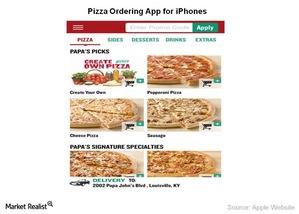Why Papa John’s Leads the Pack in Technology Implementation
Papa John’s was first to introduce online ordering at all of its US delivery restaurants in 2001 as well as first to introduce SMS text ordering in 2007.
Dec. 20 2015, Updated 9:05 p.m. ET

Papa John’s, an early adopter
Papa John’s International (PZZA) claims to be the first company to introduce online ordering at all of its US delivery restaurants in 2001. Along with this, the company was also first in introducing SMS text ordering in 2007, as well as the first to launch a nationwide digital rewards program in 2010. It was also the first to offer mobile-optimized gift cards in 2014.
The effects of technology on Papa John’s top line
Technological advancements have helped Papa John’s generate 45% of its orders through digital channels. In 2014, digital channels accounted for more than 50% of the company’s total US sales. By comparison, digital channels accounted for 45% of the total US sales of Domino’s Pizza’s (DPZ) and for 40% of the total US sales of Pizza Hut, a subsidiary of Yum! Brands (YUM).
Papa John’s introduced its new, proprietary point-of-sale system, FOCUS, in 2014, and as of March 2015, all of the company’s North American restaurants installed this system. As reported by the management, the new system allows the restaurant manager to have greater control over food and labor costs.
The company’s FOCUS system has also been integrated into Papa John’s digital ordering solutions in all traditional Papa John’s restaurants in North America, enabling the company to offer nationwide digital ordering to customers.
User-friendly services
Papa John’s e-commerce platform includes the Google Wallet alternative payment and mobile ordering system, which is compatible with iPhone and Android applications. The company also runs a “Papa Rewards” program, which is designed to increase the loyalty and frequency of use of its e-commerce ordering platform.
Other quick-service restaurants are also trying to integrate technology into their businesses. For example, McDonald’s Corporation (MCD), which makes up approximately 4% of the Consumer Discretionary Select Sector SPDR Fund (XLY), has introduced self-ordering and payment kiosks across its European stores. By comparison, Papa John’s International (PZZA) makes up 2.2% of the PowerShares Dynamic Leisure and Entertainment ETF (PEJ) and approximately 2.3% of the PowerShares Dynamic Food & Beverage ETF (PBJ).
But what about Papa John’s marketing strategies? Continue to the next part of this series for an inside look.
